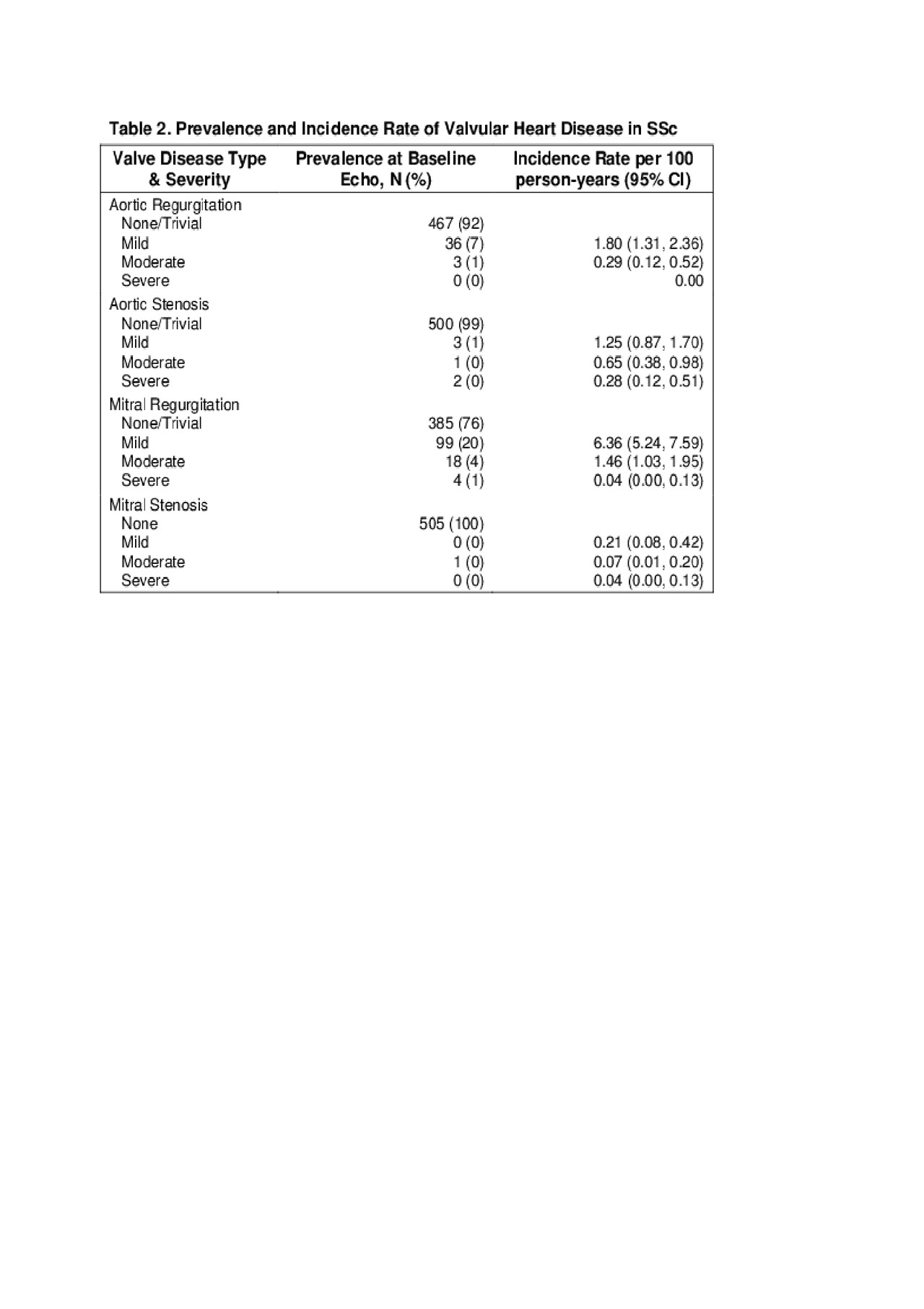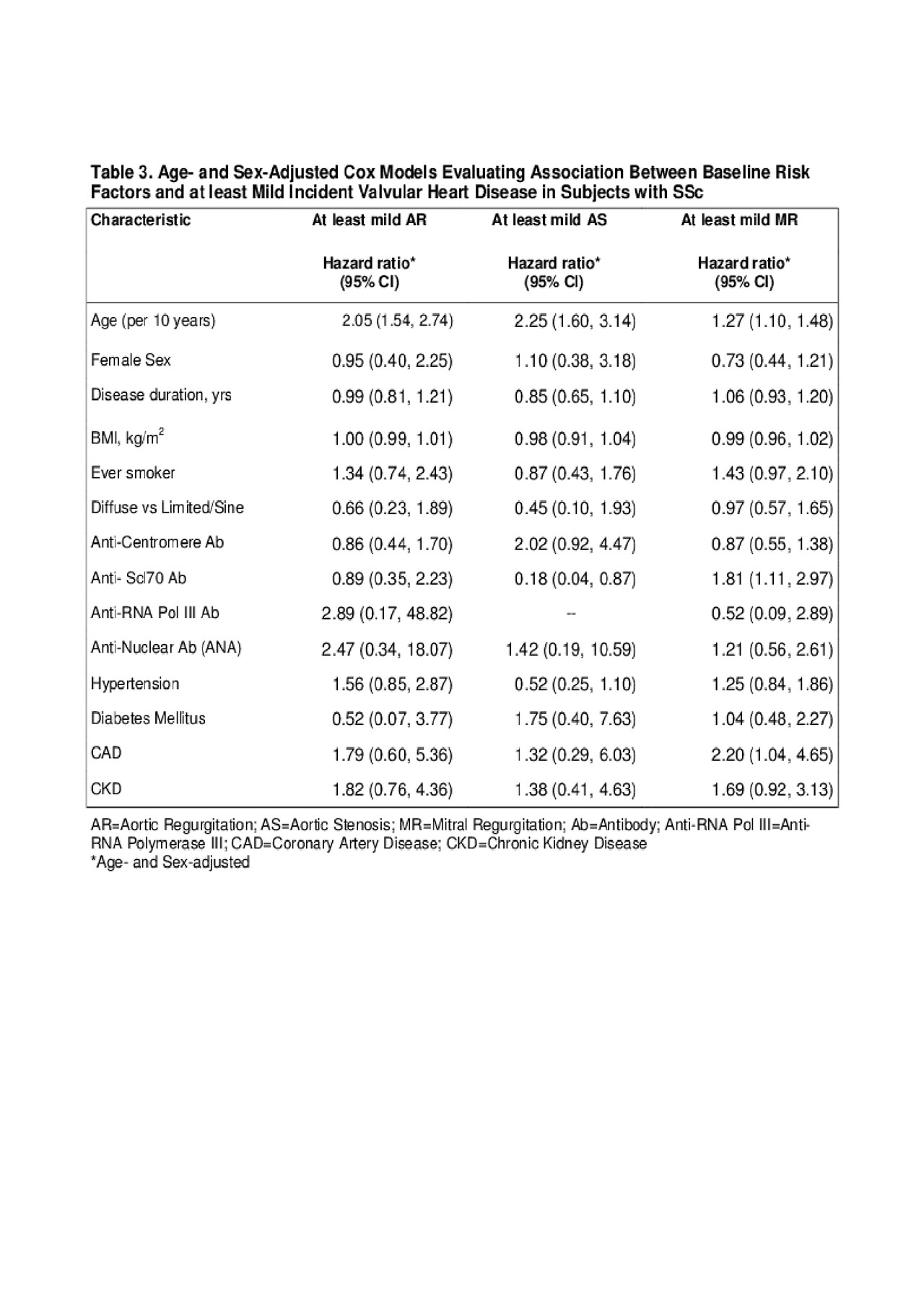Session Information
Session Type: Poster Session (Monday)
Session Time: 9:00AM-11:00AM
Background/Purpose: Systemic sclerosis (SSc) associated heart involvement remains ill-defined, with non-ischemic systolic heart failure, conduction defects, and arrhythmias often included in the definition in clinical studies. Valvular heart disease (VHD) in SSc has not been well studied. In this referral-based single-institution cohort, we evaluate the incidence rate (IR) and prevalence of VHD in SSc.
Methods: In this retrospective cohort study, medical records of 506 cases with SSc seen between 1/1/2000 and 11/10/2018, with at least two echocardiograms in the health care system, were manually reviewed. All cases included fulfilled ACR/EULAR 2013 classification criteria for SSc or 3/5 CREST criteria, and had a baseline echocardiogram within five years of diagnosis. Mild, moderate, and severe VHD was clinically defined at time of echocardiogram. IR of VHD, per 100 person-years, and prevalence of VHD were determined. Cox models were used to examine associations between incident VHD and SSc characteristics as well as cardiovascular disease (CVD) risk factors, adjusting for age and sex.
Results: Demographics, SSc characteristics, and baseline CVD risk factors are reported in table 1. Mitral regurgitation (MR) was most common, with 20% of cases having at least mild MR on baseline echocardiogram (table 2). The prevalence of at least mild aortic regurgitation (AR) or aortic stenosis (AS) was 7% and 1%, respectively (table 2). The highest IR (IR) (per 100 person-years) was 6.36 (95% CI 5.24 – 7.59) for mild MR, followed by 1.80 (95% CI 1.31 – 2.36) for mild AR and 1.25 (95% CI 0.87 – 1.70) for mild AS (table 2). Development of severe VHD was only observed for AS, with an IR of 0.28 (95% CI 0.12 – 0.51). On age- and sex-adjusted hazard models examining baseline SSc and CVD risk factors for incident VHD, age remained a significant risk factor for all VHD types (table 3). Coronary artery disease (CAD) was associated with incidence of at least mild MR (HR 2.20, 95% CI 1.04 – 4.65) (table 3). Anti-Scl70 antibody was associated with at least mild incident MR (HR 1.81, 95% CI 1.11 – 2.97) and was negatively associated with at least mild incident aortic stenosis (HR 0.18, 95% CI 0.04 – 0.87) (table 3). Anti-centromere antibody trended towards significance for at least mild incident AS (HR 2.02, 95% CI 0.92 – 4.47) (table 3).
Conclusion: MR was the most common VHD found at baseline echocardiogram in this retrospective cohort of patients with SSc, and was also the most common valve abnormality to develop, typically mild in severity. Development of any severe valve disease was less common, with severe aortic stenosis having the highest IR. Follow-up time was relatively short at a mean of less than 6 years. As VHD may cause cardiac remodeling and cardiopulmonary hemodynamic changes, additional studies examining impact of VHD on cardiopulmonary outcomes in SSc and appropriate management strategies in this population are warranted.
To cite this abstract in AMA style:
Elnagar M, Radwan Y, Elwazir M, Kurmann R, Mankad R, Osborn T, Makol A, Griffing L, Crowson C, Hinze A. Incidence Rate and Prevalence of Valvular Heart Disease in Systemic Sclerosis: A Retrospective Cohort Study from a Single Institution [abstract]. Arthritis Rheumatol. 2019; 71 (suppl 10). https://acrabstracts.org/abstract/incidence-rate-and-prevalence-of-valvular-heart-disease-in-systemic-sclerosis-a-retrospective-cohort-study-from-a-single-institution/. Accessed .« Back to 2019 ACR/ARP Annual Meeting
ACR Meeting Abstracts - https://acrabstracts.org/abstract/incidence-rate-and-prevalence-of-valvular-heart-disease-in-systemic-sclerosis-a-retrospective-cohort-study-from-a-single-institution/



